Watery Pass Name
Upon entering the cave north of Kaipo, we see that the Japanese version calls this place “Underground Water Vein” while the English version calls it “Watery Pass”:
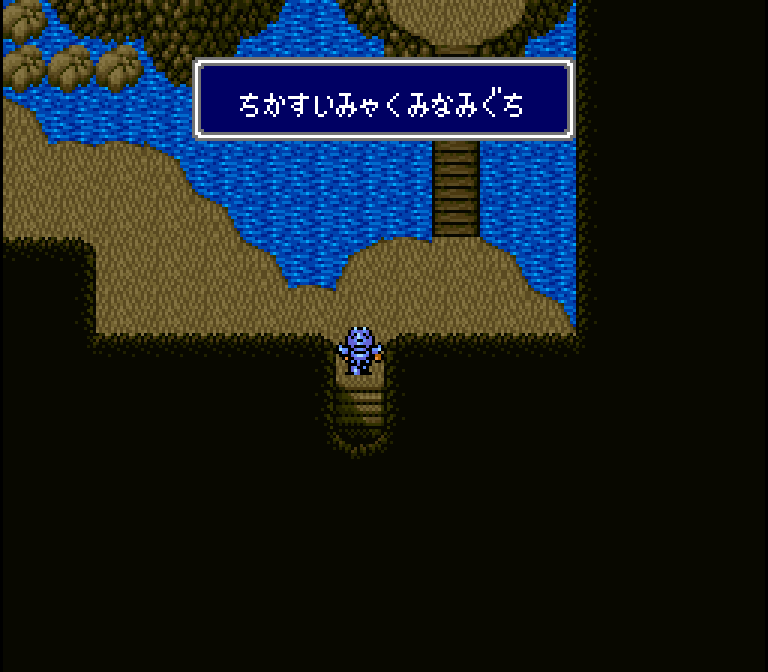 | 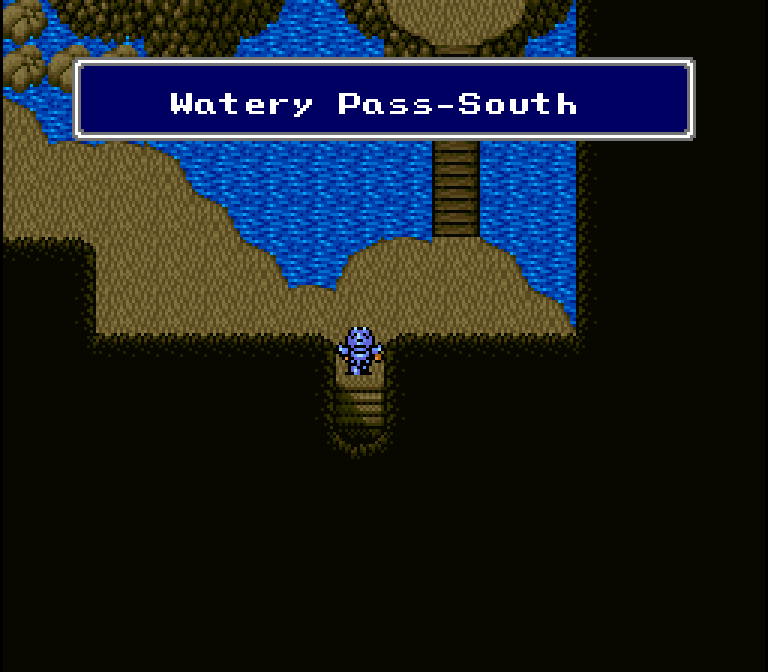 |
| Final Fantasy IV (Super Famicom) | Final Fantasy II (Super NES) |
We saw it translated as “Watery Pass” once before but translated as something else another time. It looks like “Watery Pass” seems to be the main localization name they went with.
Another extremely minor point is that it says this is the “south exit” in Japanese but just says “-South” in the English translation. It’s certainly no big deal; it means the same basic thing and I doubt the 100% full name would’ve fit anyway. This same change applies for the north exit too, incidentally.
Come to think of it, I think this is one of the first times we see the extended text box in the English localization being put to good use.
Old Obstacle Man
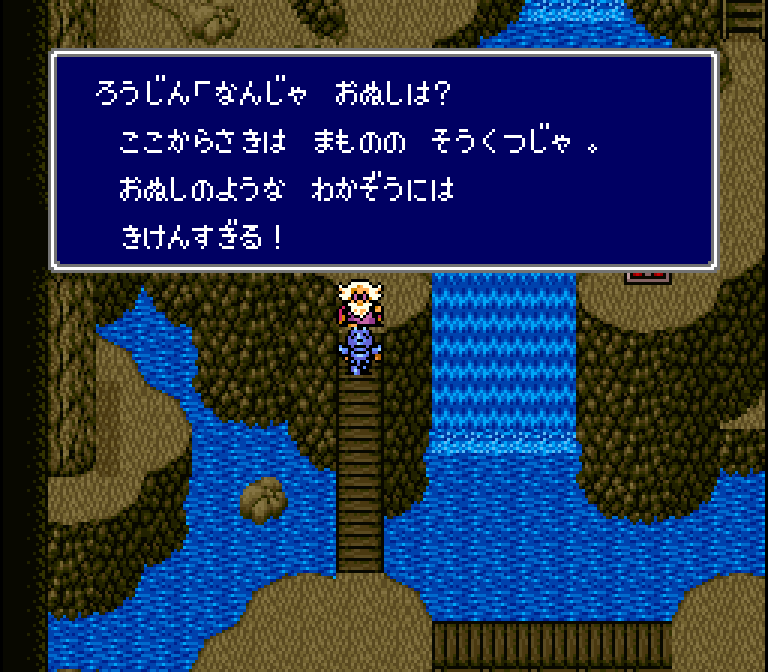 | 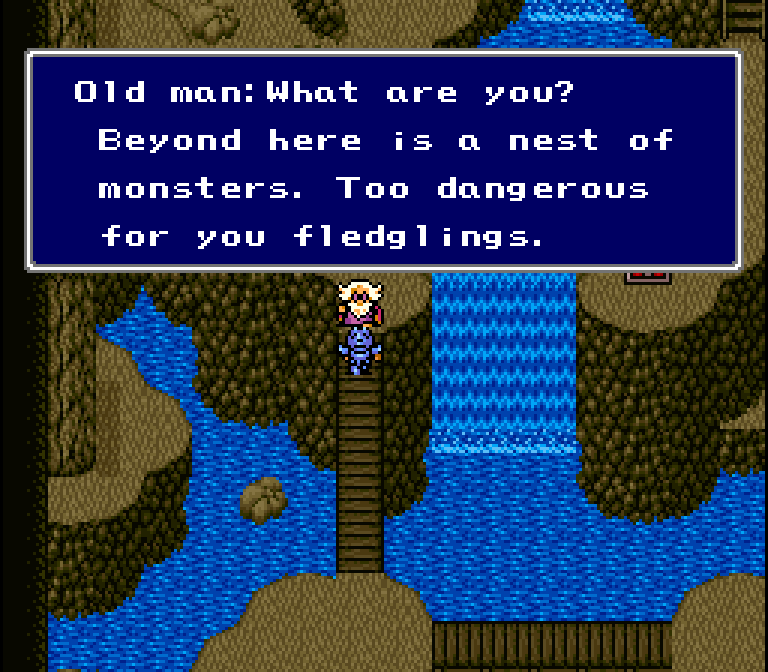 |
| Final Fantasy IV (Super Famicom) | Final Fantasy II (Super NES) |
If you come here before you talk to Rosa, Tellah will be blocking the way. What he says in English is pretty similar to what he says in Japanese.
The only two issues I can point out are:
- “What are you?” is indeed very literally what he says, but in contexts like this it’s usually more appropriately translated as something like, “Who are you?” or “What do you want?”
- In the English translation he uses “fledglings”, indicating the plural form of “you” is being used. But in the Japanese text he’s only using the singular “you”, meaning he’s referring to just Cecil.
The first mistranslation above is pretty common in older games it seems – it even happens elsewhere in this same game.
Treasure Changes
As before, some of the treasure chests’ contents have been changed in the different versions of the game. Ignoring item name changes, here are the chests that have been changed:
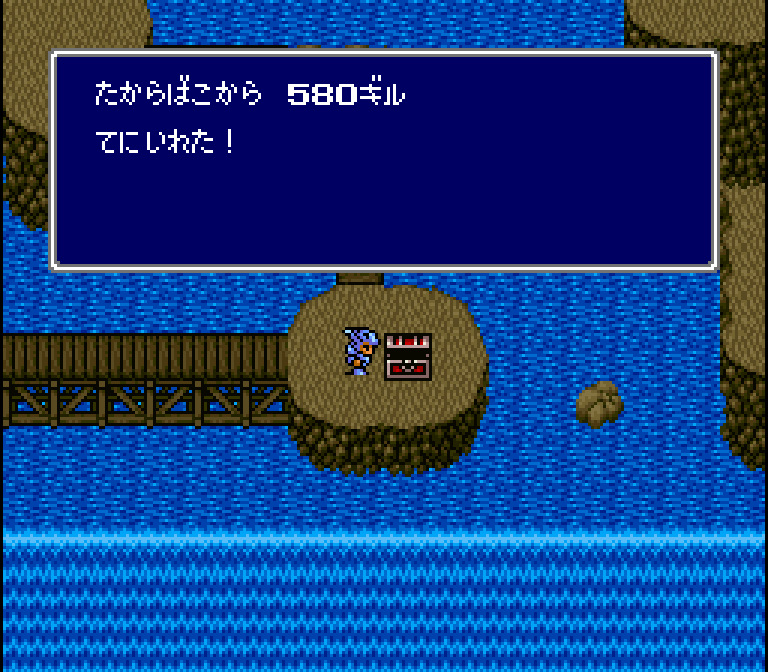 | 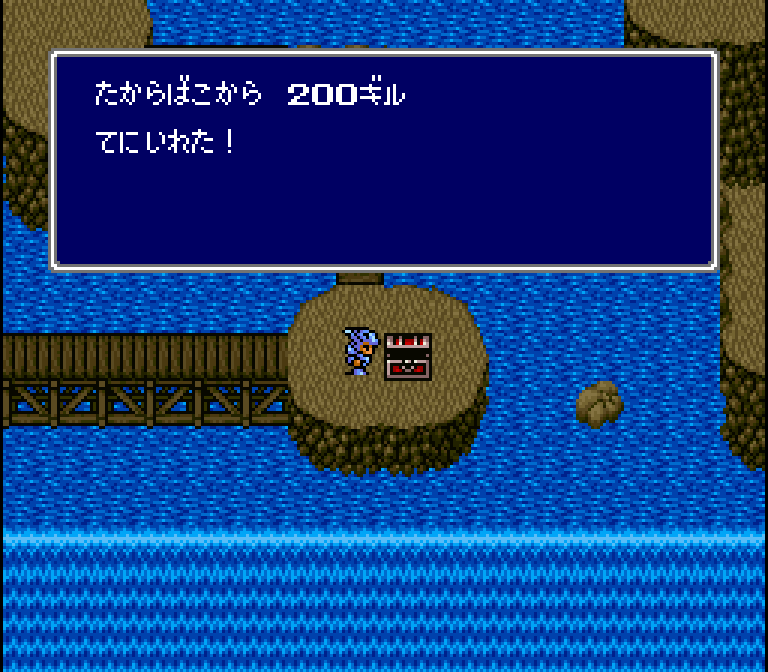 | 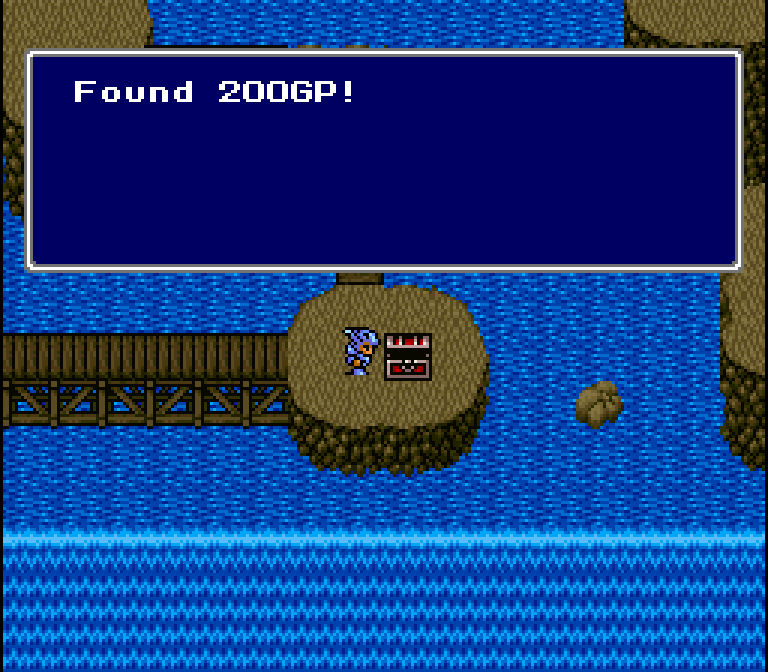 |
| Final Fantasy IV (Super Famicom) | Final Fantasy IV Easy Type (Super Famicom) | Final Fantasy II (Super NES) |
| Location: | Final Fantasy IV | Final Fantasy IV Easy Type | Final Fantasy II |
| South Exit | Maiden’s Kiss | Heal-All Medicine | Heal |
| South Exit | Bomb Fragment | 120 Gil | 120 GP |
| Waterfall | Dry Ether | Elixer | Elixir |
| Waterfall | X-Potion | High Potion | Cure2 |
| Waterfall | Phoenix Feather | 1000 Gil | 1000 GP |
| B3F | 580 Gil | 200 Gil | 200 GP |
| B3F | Bomb Fragment | Potion | Cure1 |
| North Exit | Antarctic Wind | Ether | Ether1 |
| North Exit | Bronze Hourglass | Heal-All Medicine | Heal |
| Underground Lake | Hermes Shoes | Ether | Ether1 |
Quite a lot of changes in this dungeon! I wonder why they decided to drop the 500 Gil chest to 200 for the Easy Type version, I would think that would make things less easy. Maybe they thought the secret 1000 Gil chest made up for it or something.
Meeting Tellah
 | 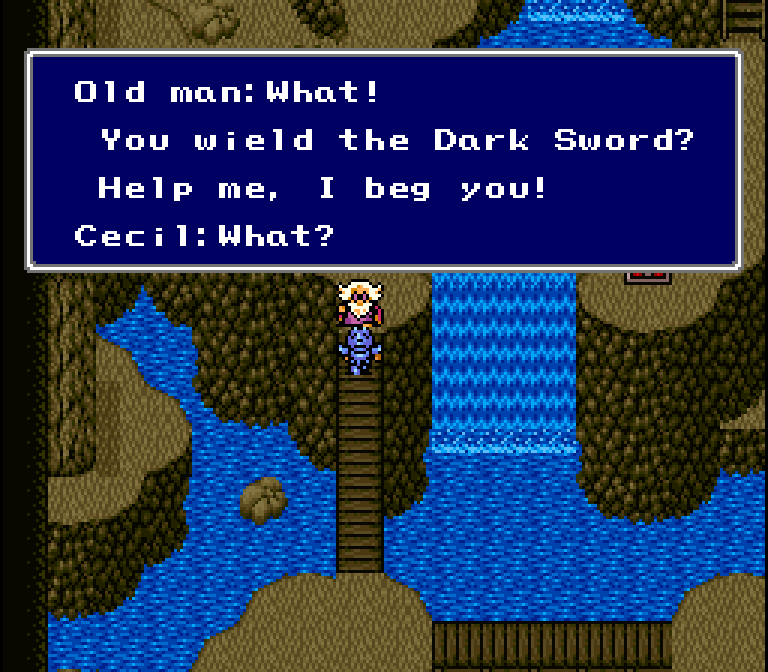 |
| Final Fantasy IV (Super Famicom) | Final Fantasy II (Super NES) |
When you first meet the old man in the underground water vein, he says in Japanese, “Hmm! You! Upon close inspection you’re a wielder of the Dark Sword, aren’t you?! Please, lend me a hand!”
The English translation is surprisingly close to this: “What! You wield the Dark Sword? Help me, I beg you!”
This is actually the first time that “Dark Sword” has actually been translated as “Dark Sword”! Until now, it was inconsistently called various other things. This sudden change and the increased quality of the translation makes me wonder if this also got quickly looked over by a native English speaker.
Tellah’s Name
In English, the old man’s name is spelled as “Tellah”. This is absolutely acceptable, and probably how I would’ve spelled it too if I had translated it back then with no prior knowledge.
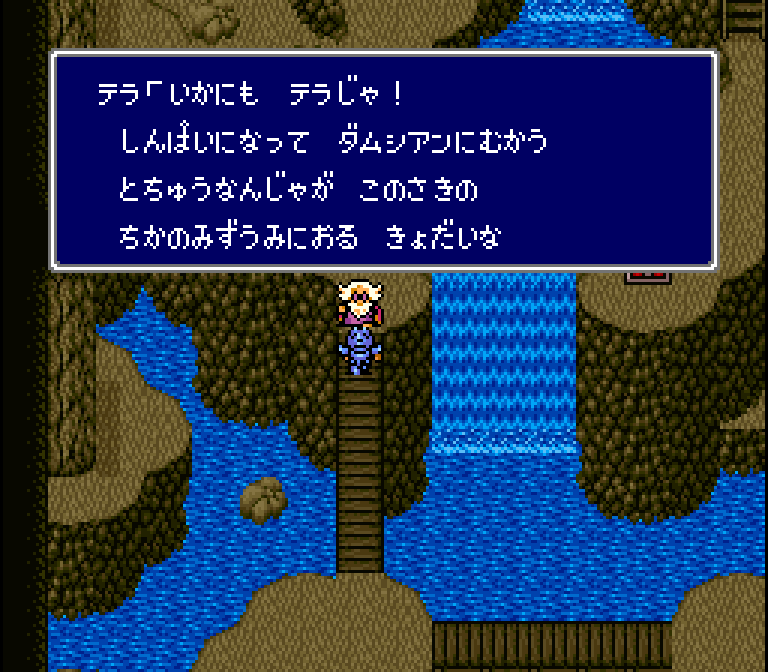 |  |
| Final Fantasy IV (Super Famicom) | Final Fantasy II (Super NES) |
But, according to the game’s manual, it looks like it should be “Tella” instead:
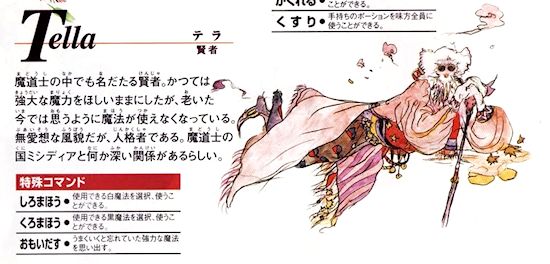
Again, Japanese creators can often get the English spellings of their own things wrong, but given some of the other names we’ve already looked at, it seems most of these spellings were competently done.
I should also mention that Tellah has a very distinct “old wise man” speech pattern in the Japanese version. Such speech patterns usually get lost in translation, so it’s not quite as present in the English translation.
Remember Battle Command
Once Tellah joins your party, you have some more magic to throw at enemies!
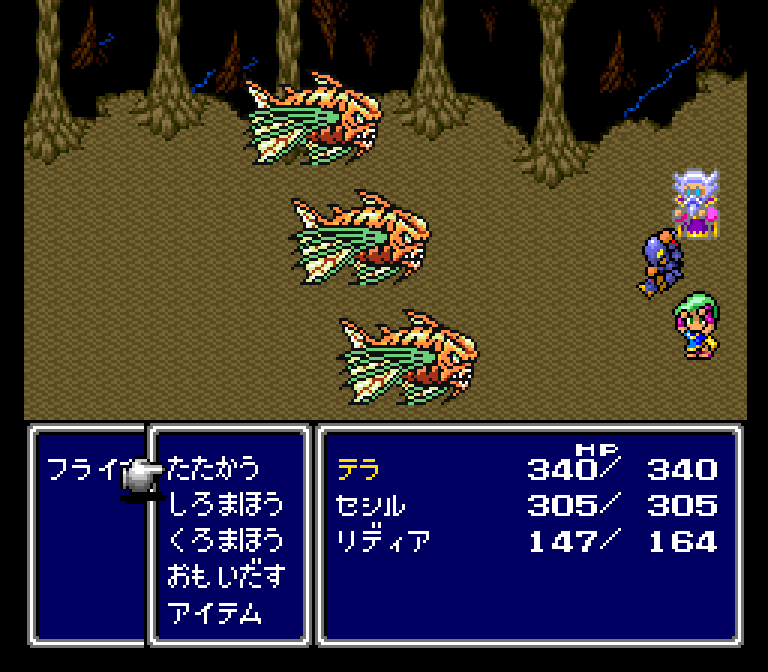 | 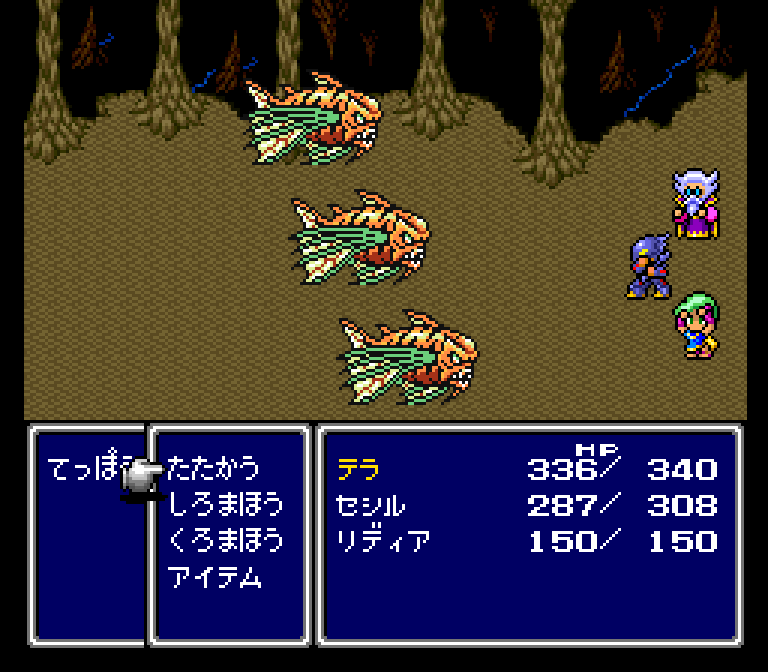 | 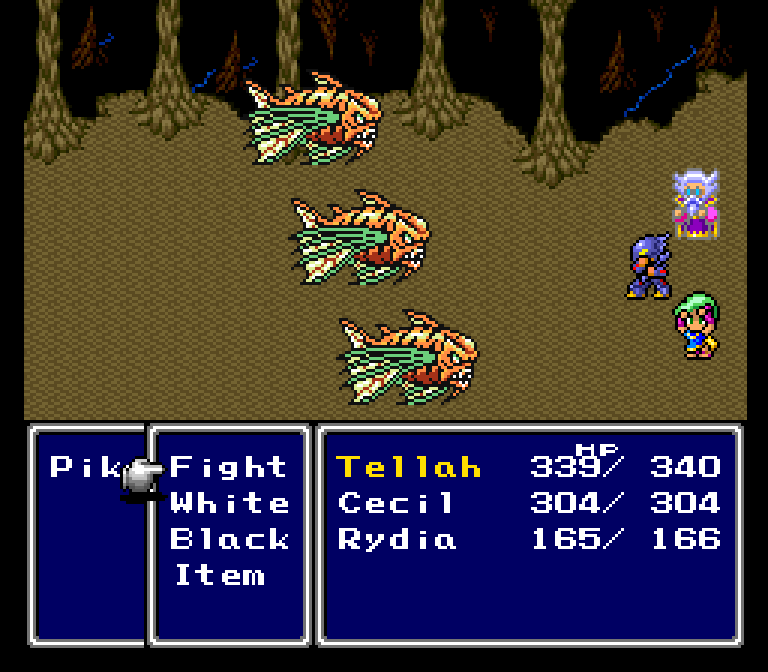 |
| Final Fantasy IV (Super Famicom) | Final Fantasy IV Easy Type (Super Famicom) | Final Fantasy II (Super NES) |
In Final Fantasy Easy Type and Final Fantasy II, Tellah has white and black magic that can be chosen from the battle menu.
In the original Final Fantasy IV, he has these and he has an extra command called “Remember”. This command will make him choose a random spell from a much larger spell list – most of which he doesn’t have at this point in time. Sometimes it’ll be a really useful spell and sometimes it’ll be a not-so-useful spell. Using it is a bit of a gamble.
I’m not quite sure why this was removed from Final Fantasy IV Easy Type and Final Fantasy II – maybe it was just to simplify the battle system. I think having the “Remember” option helps better drive home the fact that Tellah used to be a kickass mage. I bet it also made some players go, “Holy crap, there’s some awesome magic to be had later!”
What’s most interesting though is how Final Fantasy IV and Easy Type had Cecil’s special Dark Sword-related command but in this case only Final Fantasy IV has Tellah’s special command.
Magic Spell Names
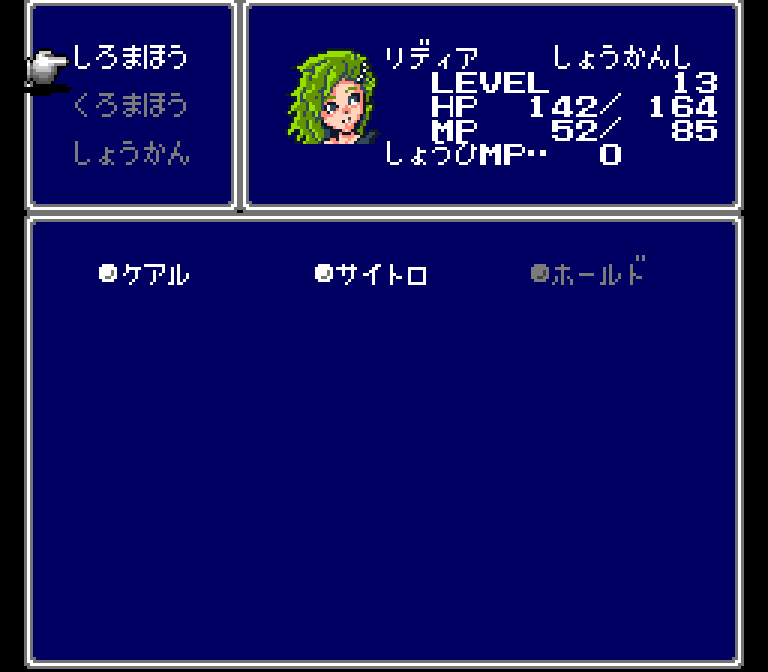 | 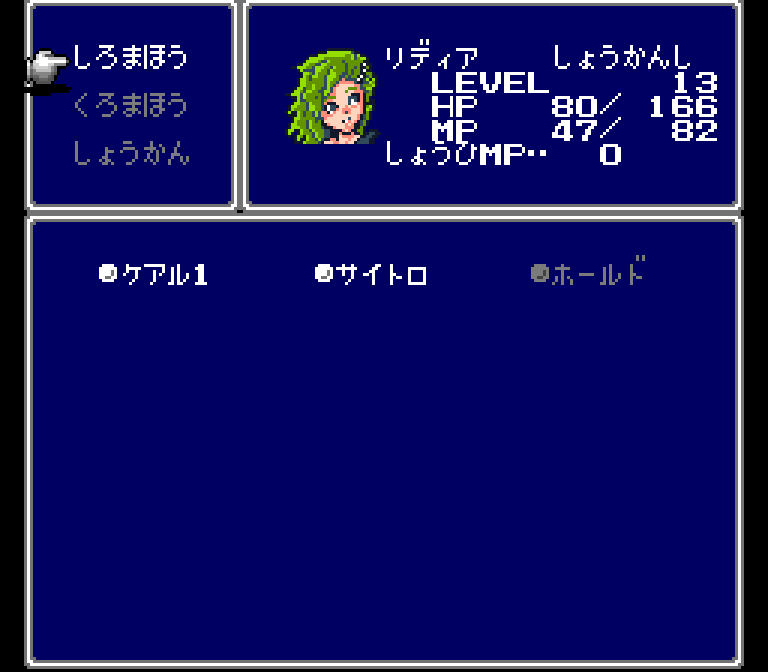 | 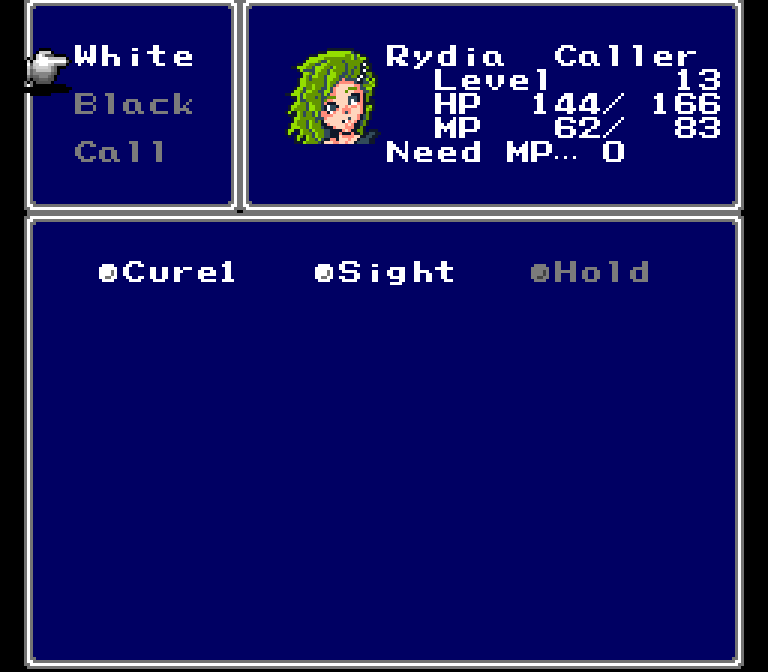 |
| Final Fantasy IV (Super Famicom) | Final Fantasy IV Easy Type (Super Famicom) | Final Fantasy II (Super NES) |
Since we’re on the topic of magic, and since this is the first time in the game that magic really becomes usable, it’s worth mentioning that spell names were changed between Final Fantasy IV and Final Fantasy IV Easy Type.
The most obvious change at this point in the game is that “Care”, the HP-restoring spell, is called “Care 1” in Final Fantasy Easy Type. So it looks like this system of using numbers to signify a spell’s strength was in Easy Type, and from there it went to the English localization. Or something along those lines, anyway.
I don’t think any other Japanese Final Fantasies used this numbering system, it seems to be a Final Fantasy IV Easy Type-only thing. But if I’m wrong definitely let me know.
Secret Room
There’s a secret room near the beginning of this dungeon, shortly after you get Tellah. Just walk under the waterfall! I remember being amazed by this as a kid, I must have missed it my first playthrough or two.
Anyway, this room’s name is different in Japanese and English:
 | 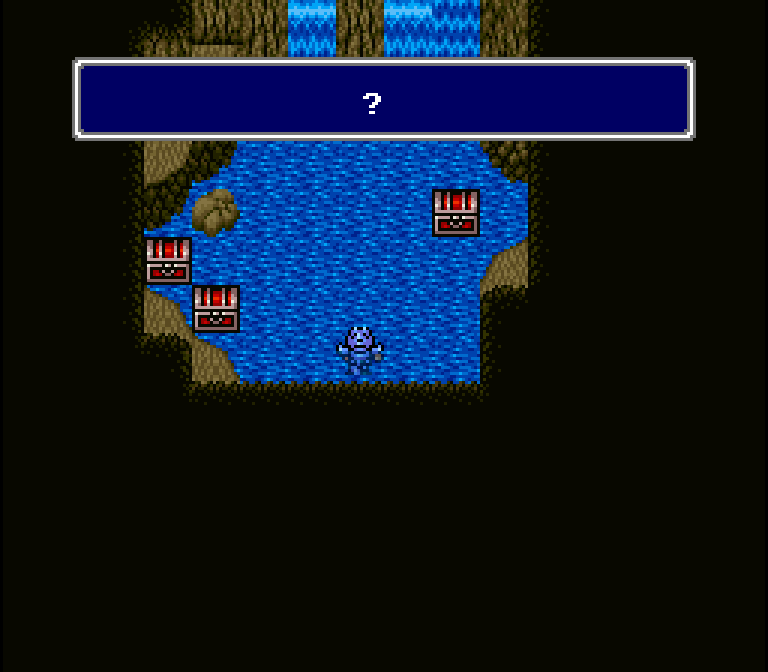 |
| Final Fantasy IV (Super Famicom) | Final Fantasy II (Super NES) |
In Japanese, it’s “Hidden Room” or “Secret Room”.
In English, it’s just called “?”.
And, as we already saw, the contents of all the chests in this room were changed for Final Fantasy IV Easy Type and Final Fantasy II.
Save Rooms
Another somewhat well-known and obvious difference between the original game and Easy Type / Final Fantasy II is the save spot marker:
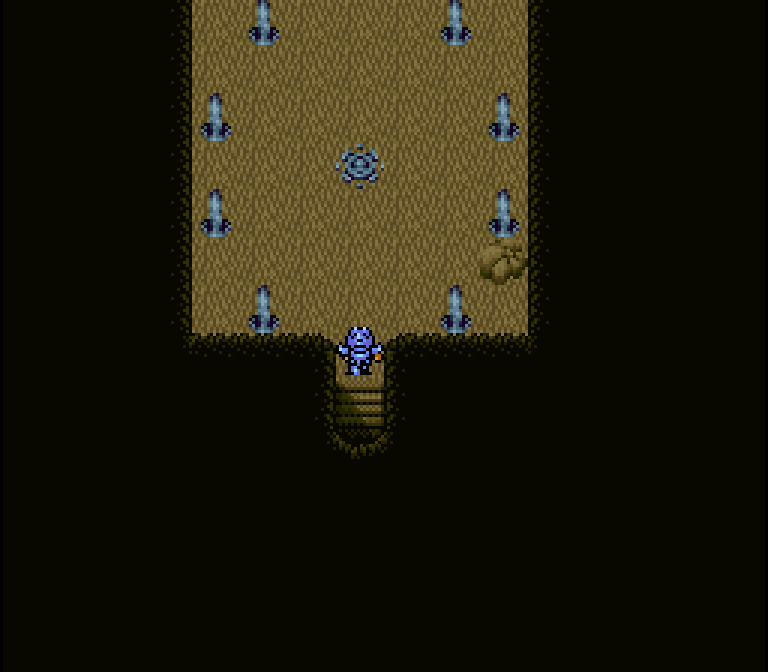 |  |  |
| Final Fantasy IV (Super Famicom) | Final Fantasy IV Easy Type (Super Famicom) | Final Fantasy II (Super NES) |
I didn’t realize it until only now, but the Japanese version is meant to be a spot for a campfire – we even see it in the scene where Cecil and Tellah talk while Rydia sleeps. It even makes sense that that’s where you can use tents and such.
In Final Fantasy IV Easy Type and Final Fantasy II, this was changed to a circle thing with a big letter “S” inside it.
I definitely prefer the S mark one, as it’s easy to spot and it’s clear that it can be used for something. It looks kind of strange that there’s a campfire on it in the Tellah/Cecil scene, though.
Save Room Lore
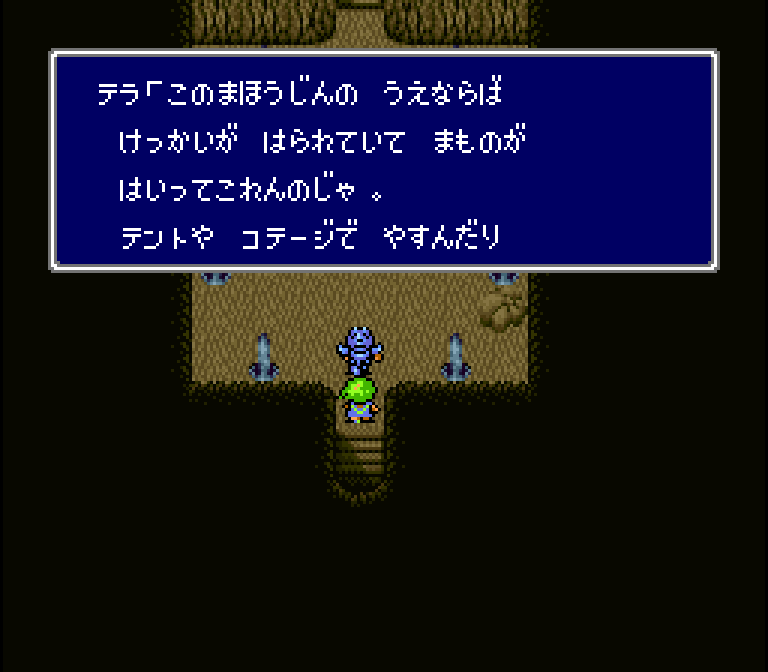 |  |
| Final Fantasy IV (Super Famicom) | Final Fantasy II (Super NES) |
Upon entering the first save spot room in the game, Tellah calls the area around the save spot a “magic circle” in Japanese.
In English, he calls it a “special field”.
If you’ve watched any Japanese anime or played any Japanese games in the last decade or so then you’ve probably seen tons of these “magic circles”. It refers to this sort of thing:
 |
“Special field” works fine as a localization, although it does lose the connotation that it’s magical in nature and that the pillar-type things are the corner points of that field. I thought they were just decorations until I played the Japanese version.
Campfire Scene
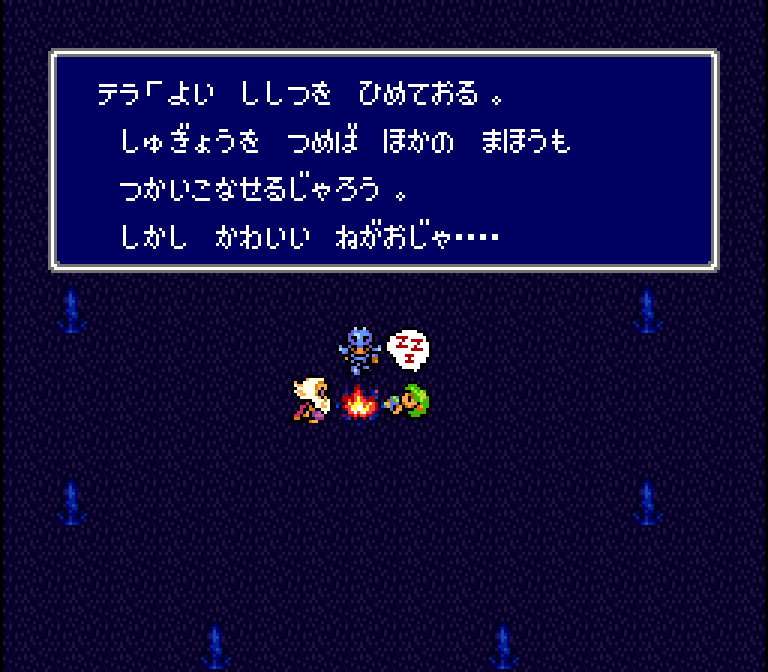 |  |
| Final Fantasy IV (Super Famicom) | Final Fantasy II (Super NES) |
During Tellah’s discussion with Cecil, there’s a part where Tellah is looking at Rydia and says, “She certainly has a cute sleeping face…”
This line is completely absent in the English localization. I’m assuming it was due to space restrictions.
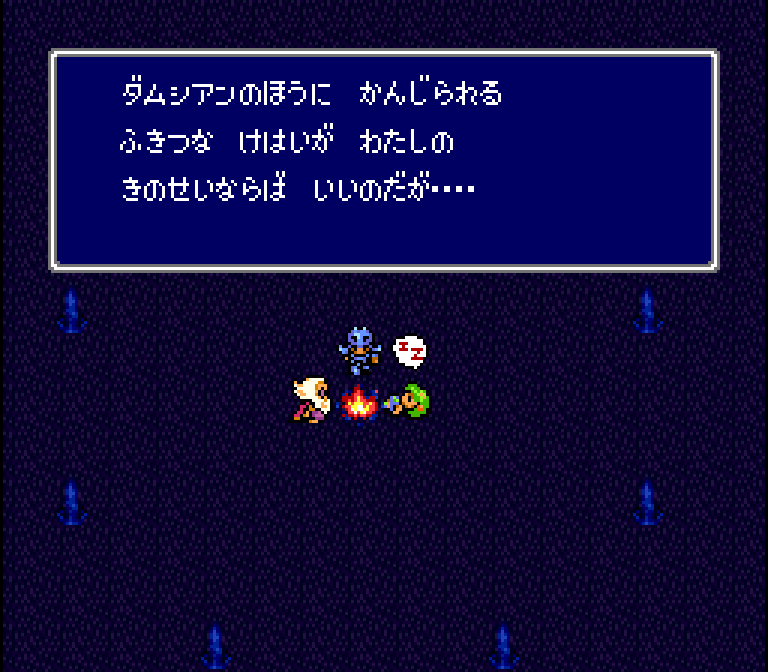 | 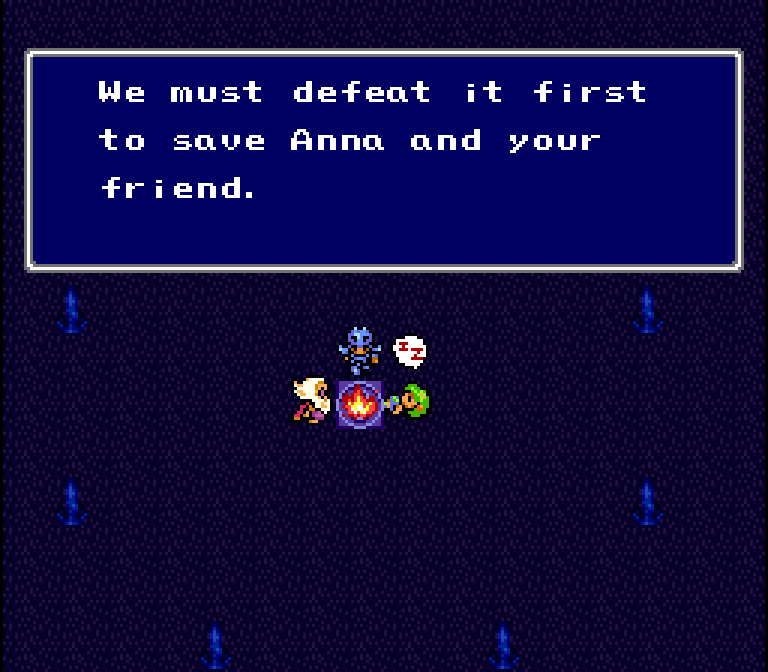 |
| Final Fantasy IV (Super Famicom) | Final Fantasy II (Super NES) |
When Tellah finishes talking a short while later, he says in Japanese, “I just hope the ominous feeling I’m sensing coming from Damcyan’s direction is just my imagination…”
This line is absent in the English script too.
I’m puzzled as to why this line would be taken out since it’s genuinely foreshadowing what’s to come and isn’t just some unimportant NPC text. Maybe it was another ROM space issue?
Secret Passages
There are lots of hidden passages all throughout this game. In Final Fantasy IV, they blend in perfectly with the walls, so you wouldn’t know or suspect they were there unless you saw something that couldn’t normally be reached.
In Final Fantasy IV Easy Type and Final Fantasy II, these hidden passages are made to look a little different from the surrounding wall, thus making them more obvious to the player.
The first real secret passage in the game appears in this dungeon, so let’s take a look:
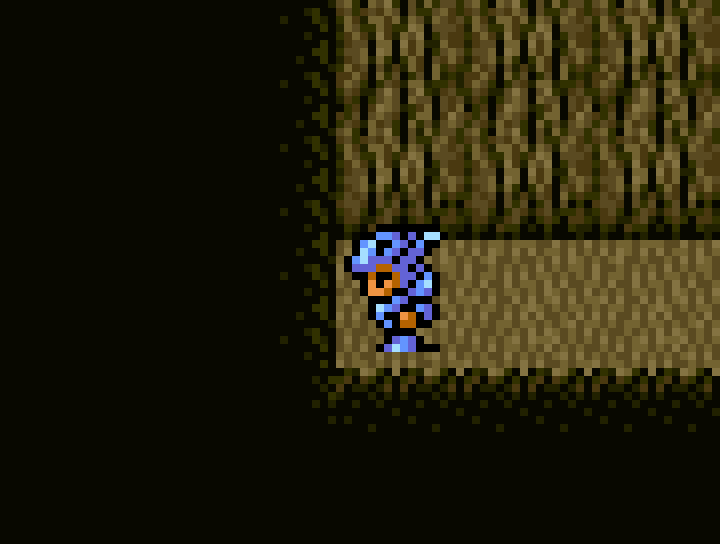 |  |
| Final Fantasy IV (Super Famicom) | Final Fantasy IV Easy Type and Final Fantasy II |
It’s actually not too obvious in this screenshot, but in other places in the game and on different TVs/monitors these secret passageways in Easy Type / Final Fantasy II are very easy to see.
Resting Outside
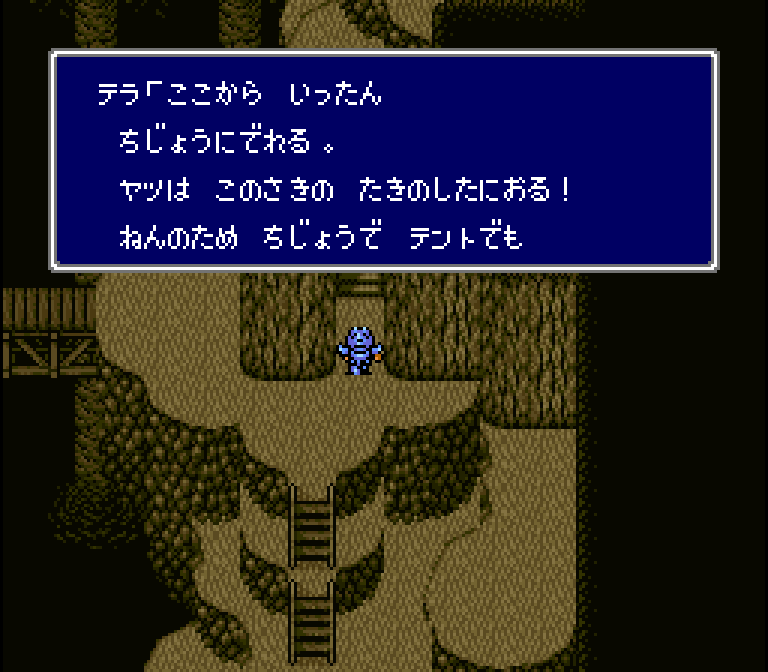 | 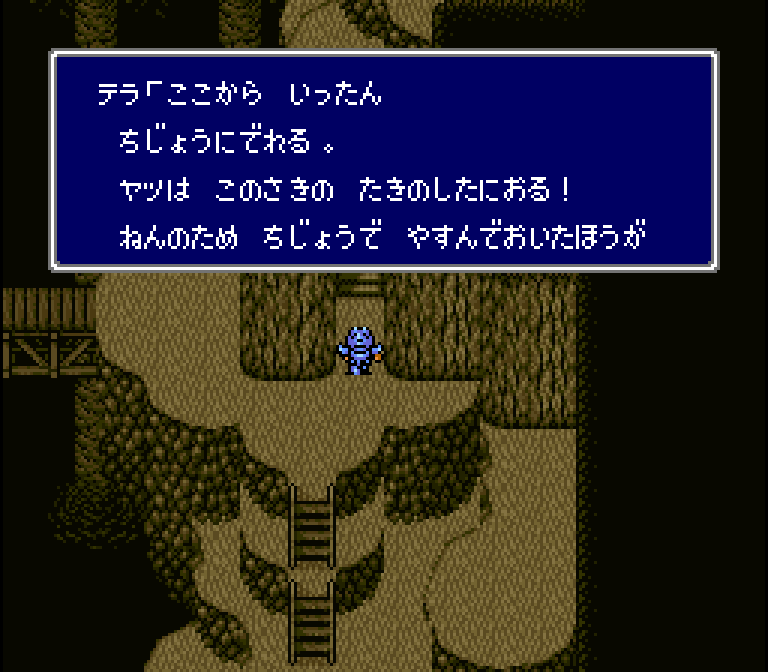 | 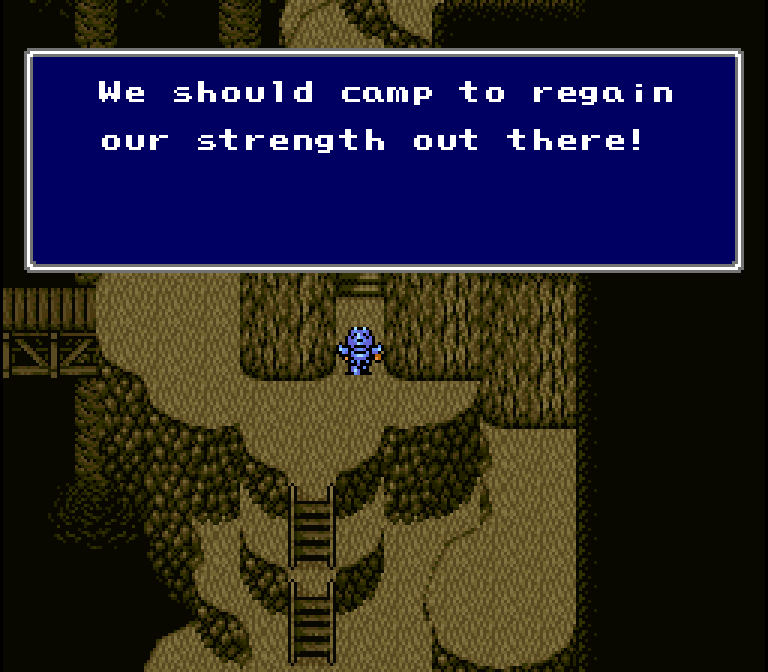 |
| Final Fantasy IV (Super Famicom) | Final Fantasy IV Easy Type (Super Famicom) | Final Fantasy II (Super NES) |
This dungeon is unusual in that at one point you have to leave the cave, go back outside, and then go into another cave.
Just as you’re about to leave the first cave, Tellah stops and says something:
| Final Fantasy IV (basic translation) | Final Fantasy IV Easy Type (basic translation) | Final Fantasy II (Super NES) |
| We can temporarily return to the surface from here. | We can temporarily return to the surface from here. | We can go out from here. |
| It (the monster) is at the bottom of the waterfall up ahead! | It (the monster) is at the bottom of the waterfall up ahead! | The monster is in the cave beyond there. |
| Just to be safe, we should set up a tent or something when we’re above ground. | Just to be safe, we should rest when we’re above ground. | We should camp to regain our strength out there! |
The most interesting thing here is that Final Fantasy IV’s script says to “set up a tent or something” when they’re above ground, while the Easy Type script simply says to “rest”. Oddly enough, the Final Fantasy IV text is more specific and helpful.
We see the English text is closer to the Easy Type text in that it doesn’t specifically say to use a tent item.
Location Names
Some other location text boxes are ever-so-slightly different in Japanese and English too.
For example, when you first enter the second cave, the Japanese text calls it something like, “Waterfall that Leads Underground” while the English text just says “Waterfalls”:
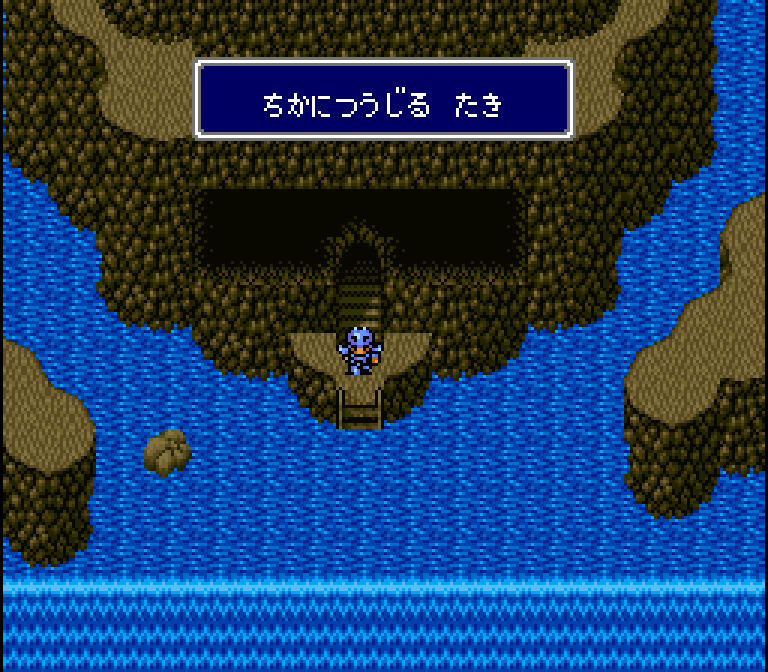 | 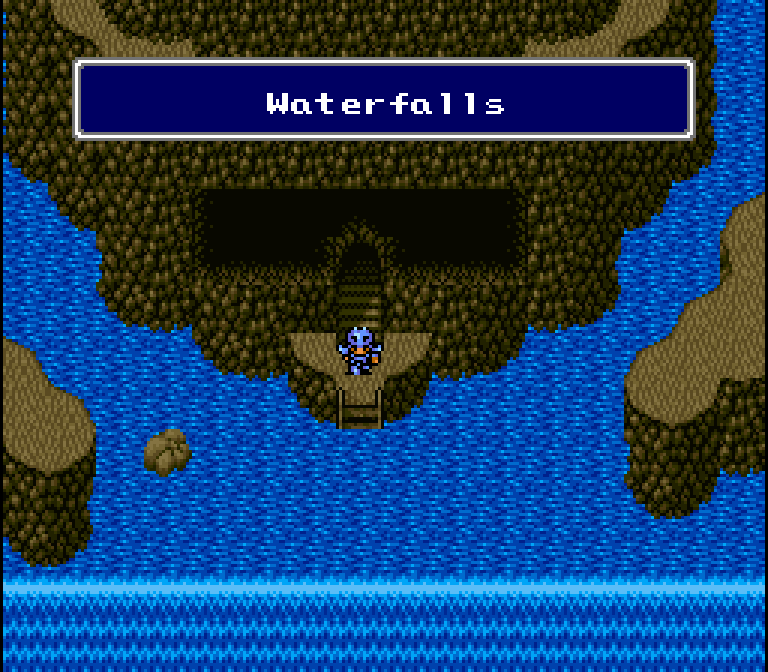 |
| Final Fantasy IV (Super Famicom) | Final Fantasy II (Super NES) |
Also, the final room in the dungeon is called “Underground Lake” in the Japanese text but just “Lake” in the English text:
 | 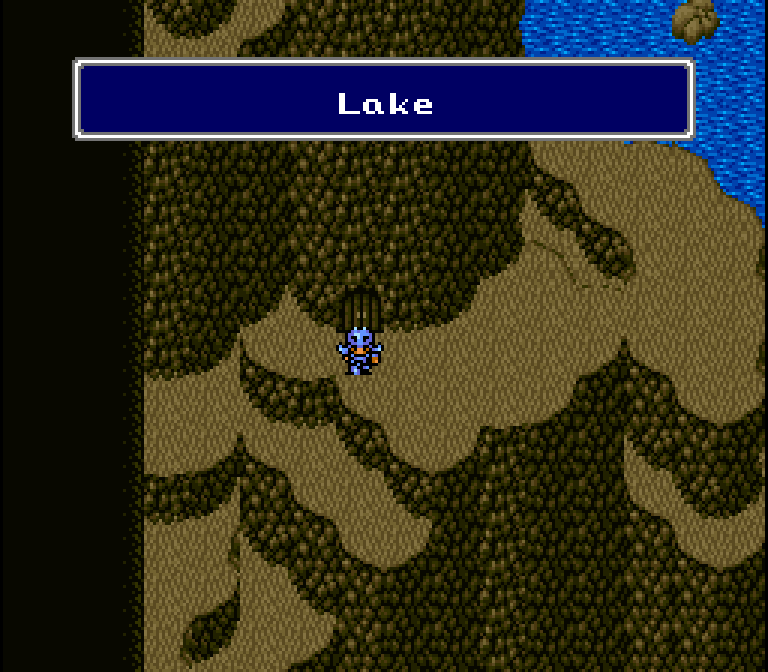 |
| Final Fantasy IV (Super Famicom) | Final Fantasy II (Super NES) |
This is certainly no big deal, but I thought I’d mention it anyway for completeness’ sake.
Octomamm / Octo-Mammoth
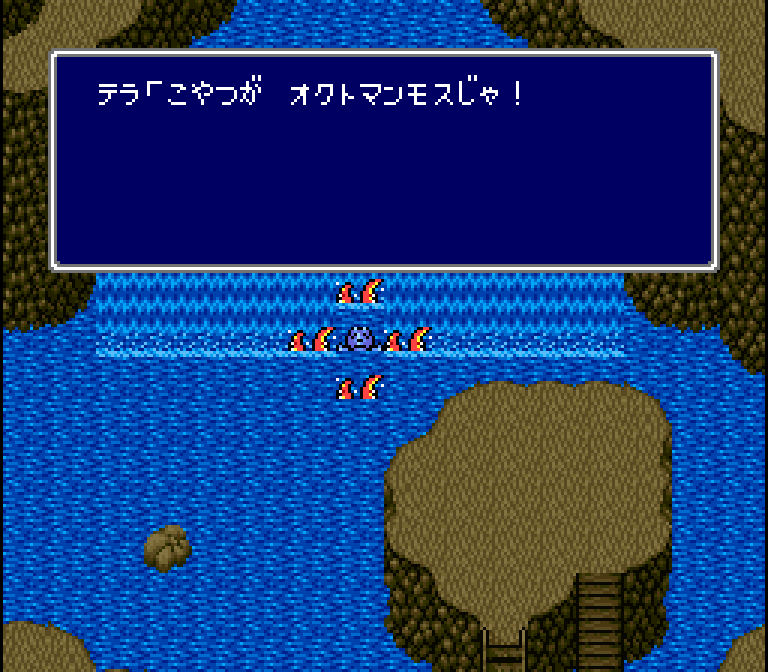 | 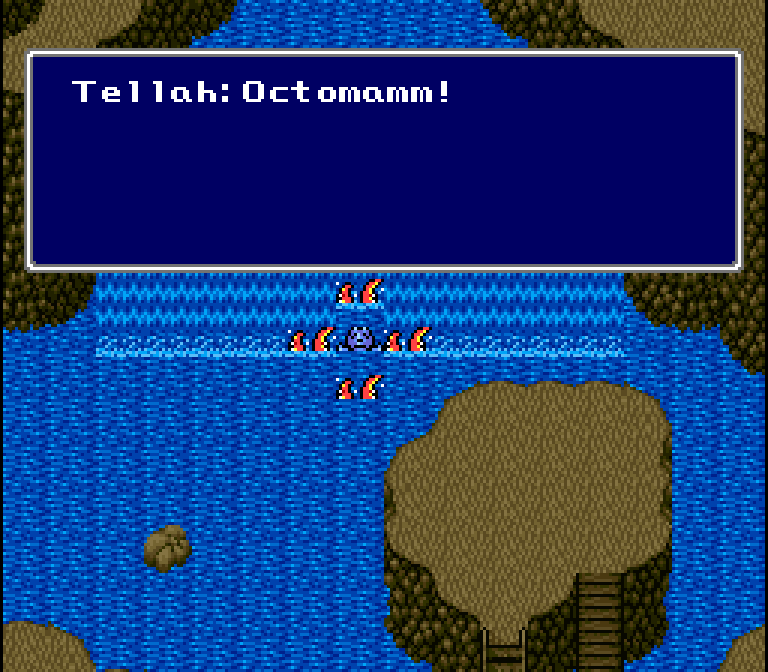 |
| Final Fantasy IV (Super Famicom) | Final Fantasy II (Super NES) |
When I first played Final Fantasy II, I was confused by this boss’s name – “Octomamm”. For some reason it made me think the enemy was either a mother or at least female – which sort of fit because we see another boss with a mother-themed name soon enough.
It didn’t dawn on me until I played the Japanese version that “mamm” was short for something: “mammoth”.
So the actual name of this boss in Japanese is something like “Octomammoth” or “Octo-Mammoth”.
Tellah’s Encouragement
Once you’ve weakened the Octomammoth quite a bit, Tellah starts talking:
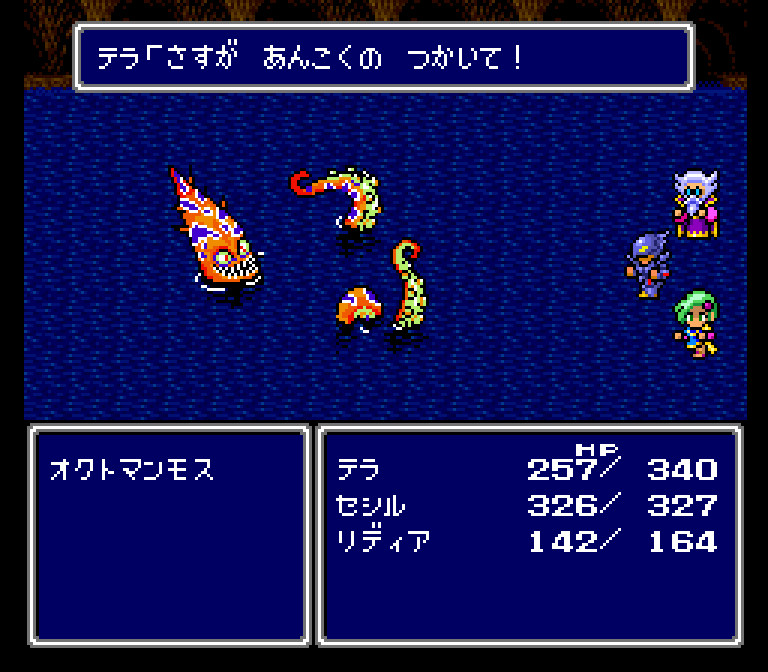 |  |
| Final Fantasy IV (Super Famicom) | Final Fantasy II (Super NES) |
In Japanese he says something like, “Just as I’d expect from a wielder of the Dark Sword!”
The actual word used in Japanese is “sasuga”, which is always a really tough word to put into English. In this case, it sort of translates to “as expected” or “true to one’s reputation”.
Anyway, in English, he just says, “Good job!”
I guess the reason I’m even mentioning this is that it’s clear in the Japanese version that he’s speaking specifically to/about Cecil and not just the whole group in general.


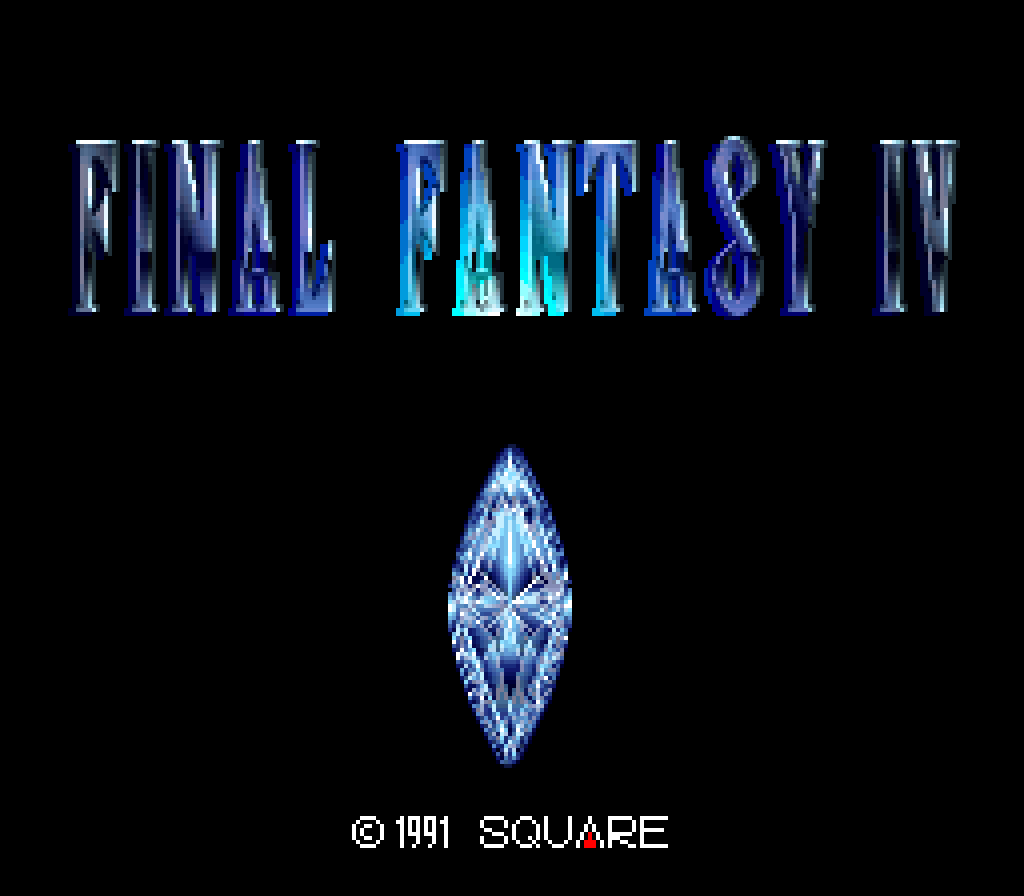
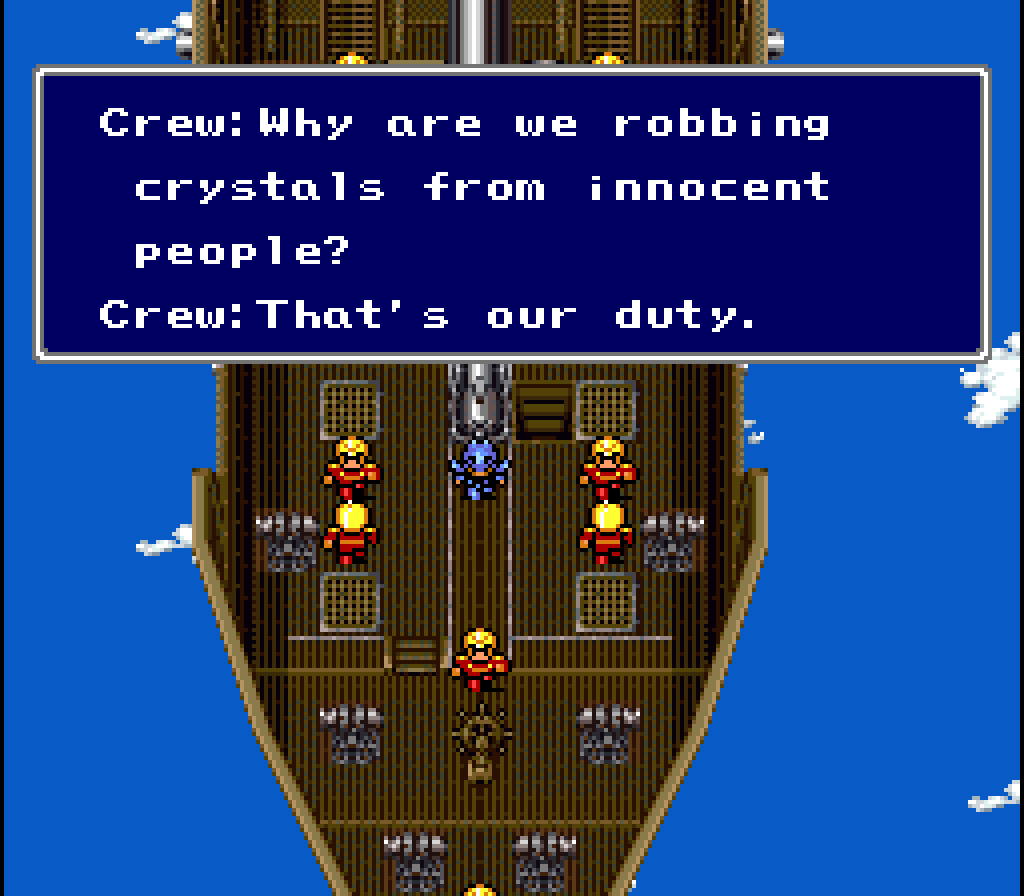
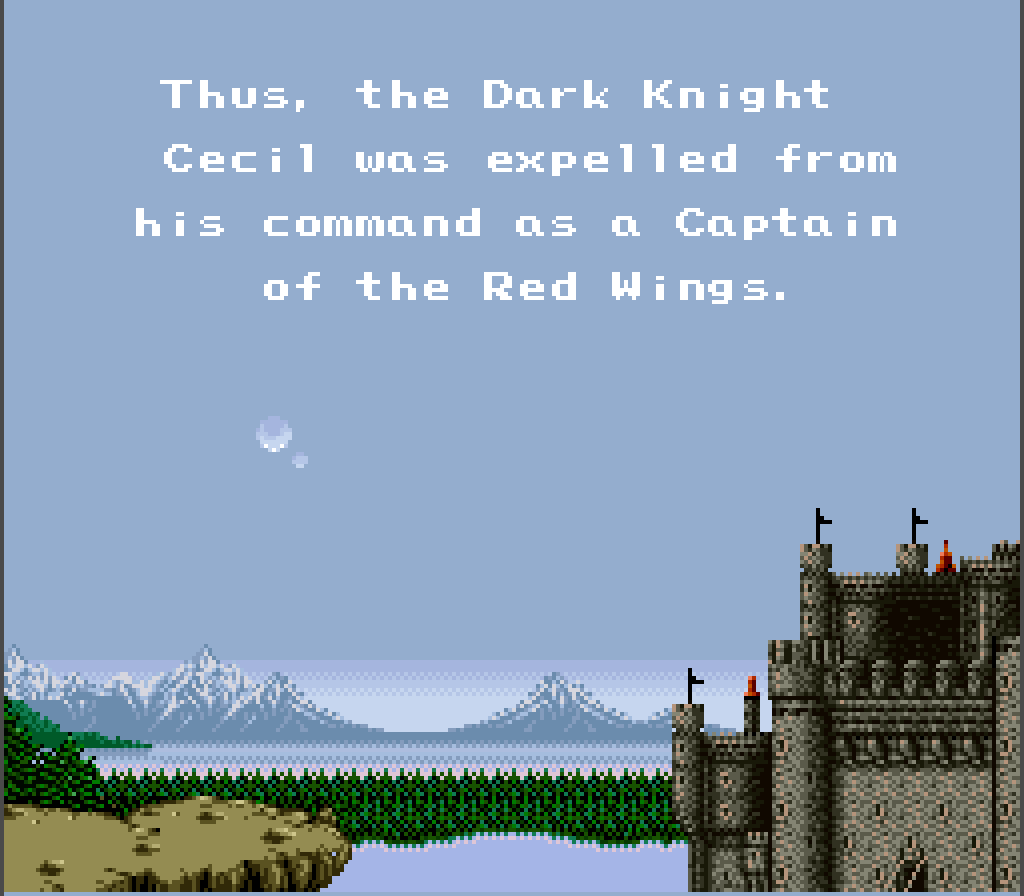
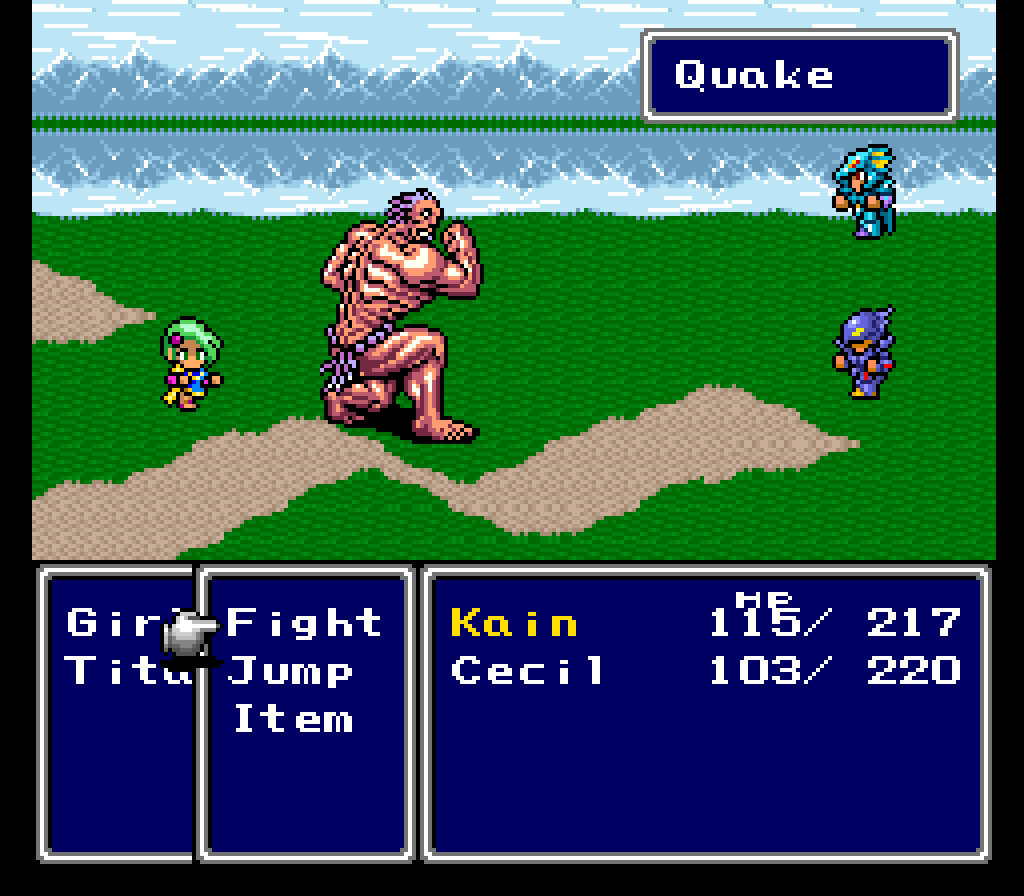
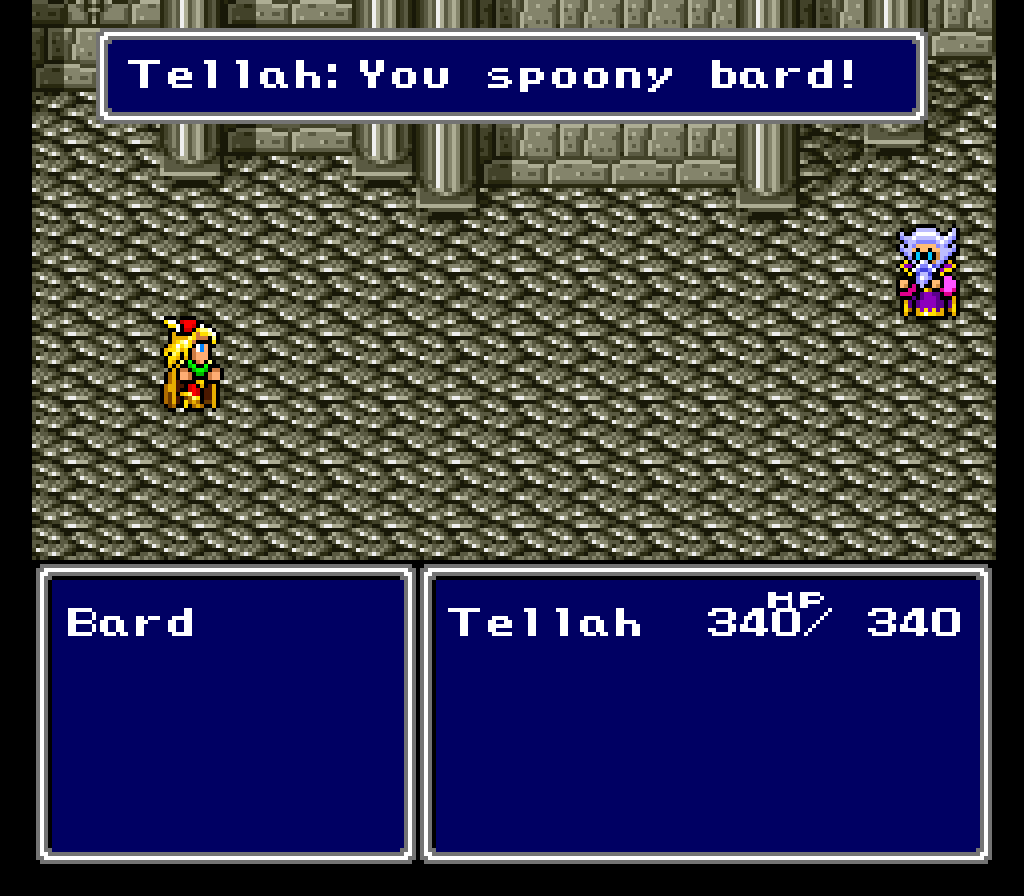
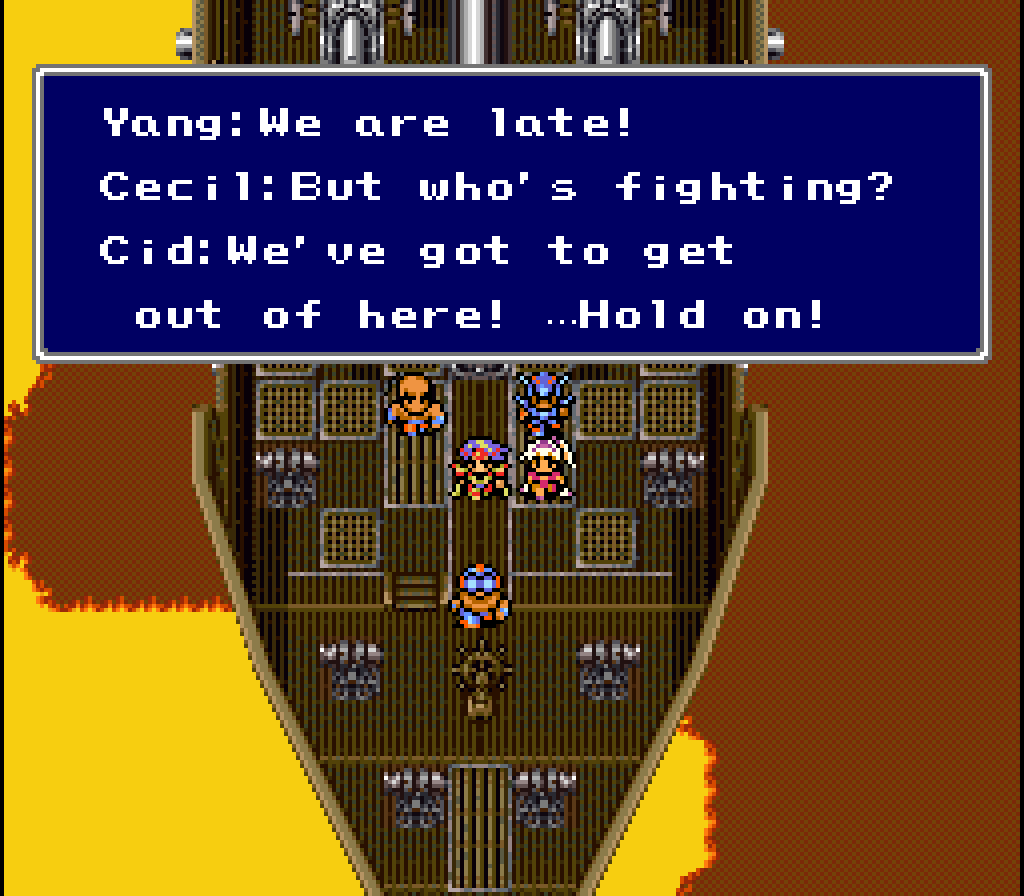
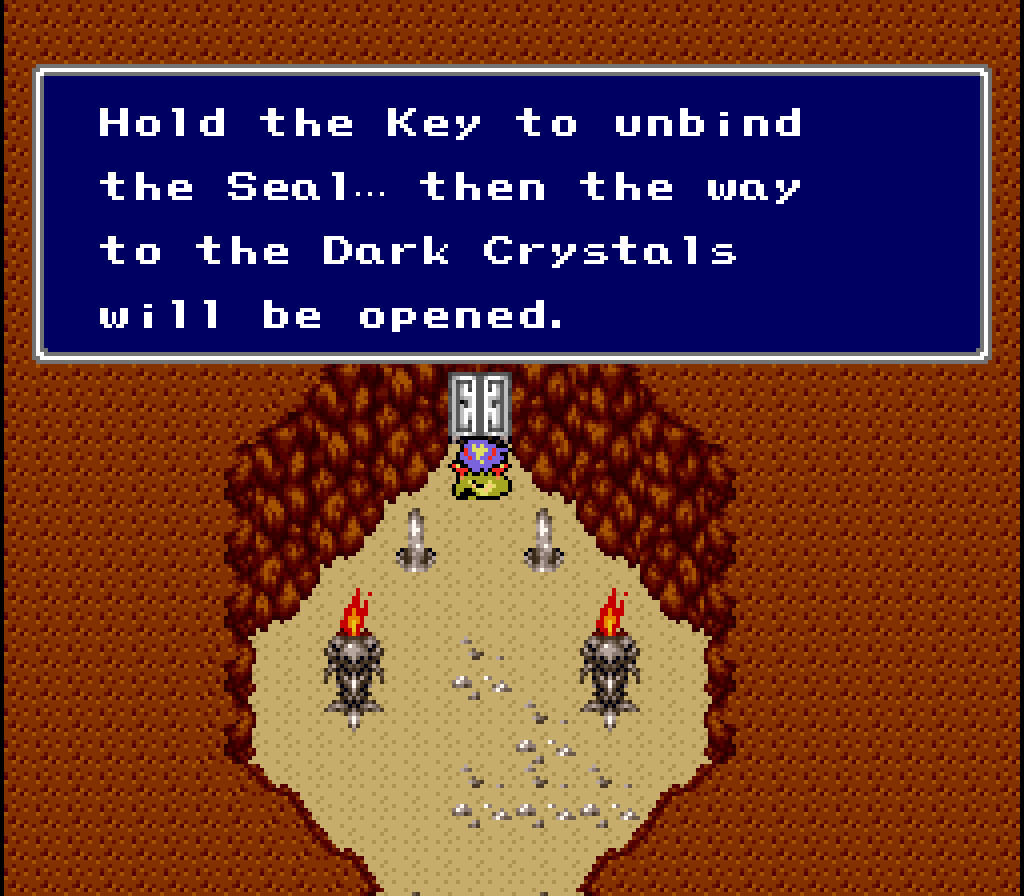
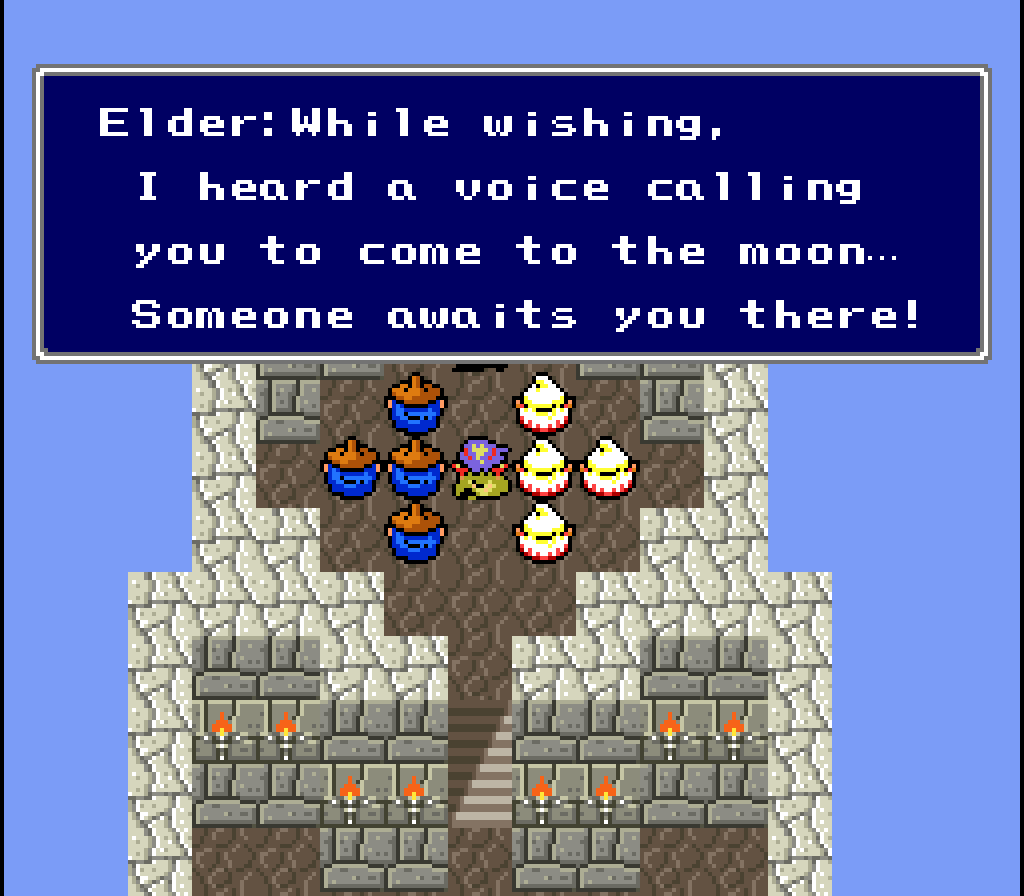
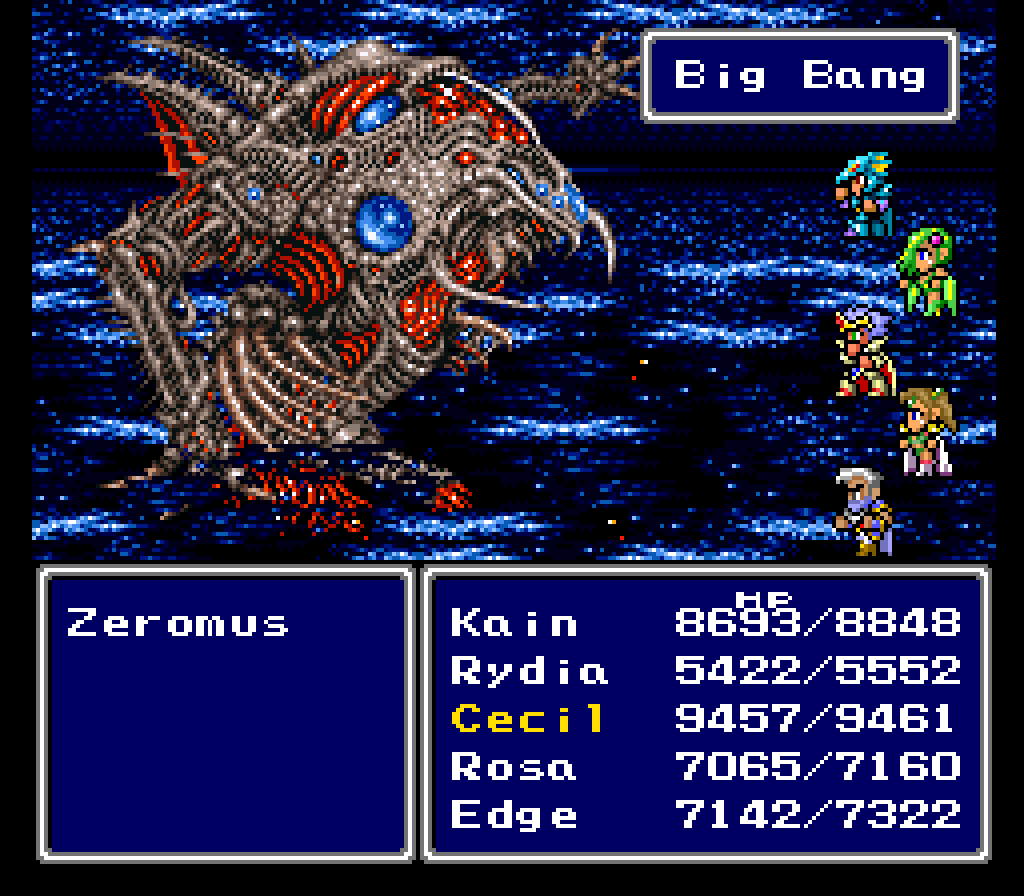
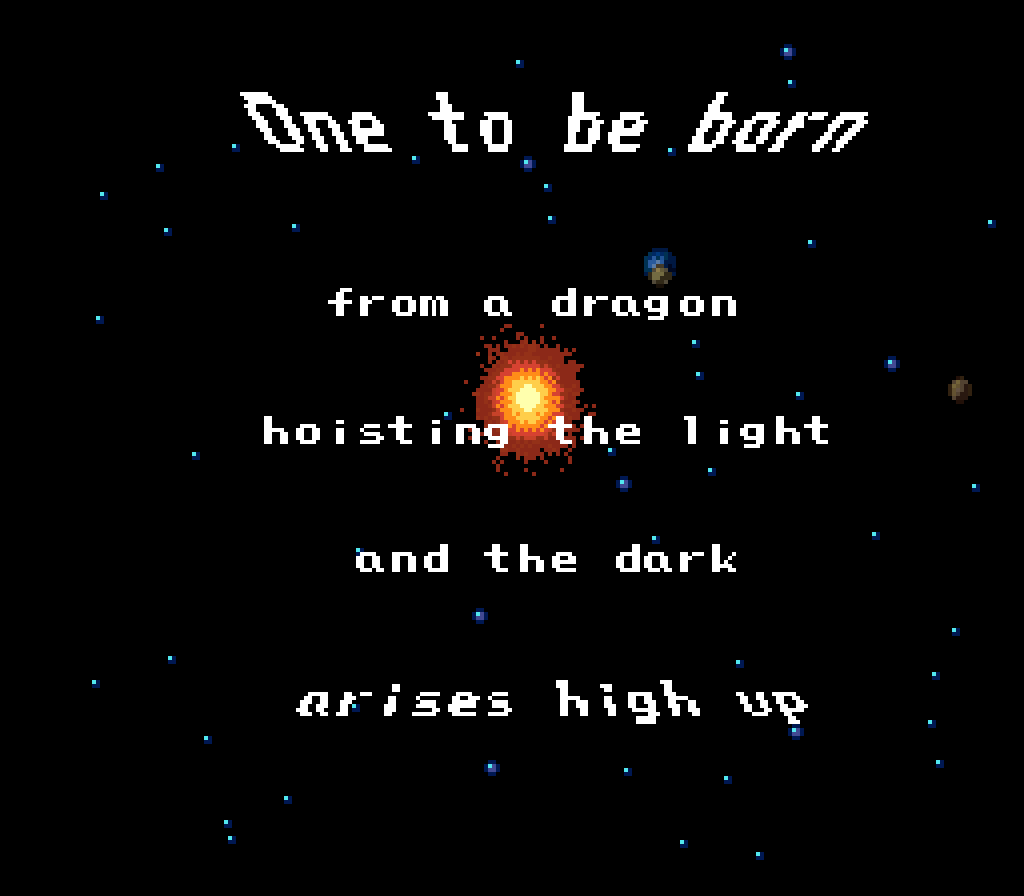
![press start to translate [Final Fantasy IV] press start to translate [Final Fantasy IV]](https://legendsoflocalization.com/wp-content/uploads/2019/08/bbenma.png)
No Comments